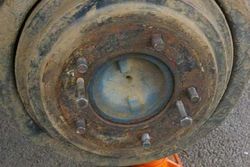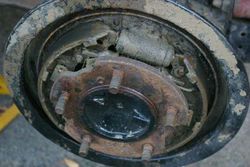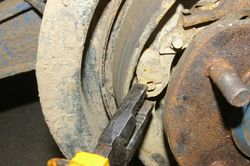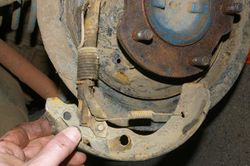![]() The content of any article might be expanded / improved in the future - revisit it sometimes.
The content of any article might be expanded / improved in the future - revisit it sometimes.
![]() Seen a mistake? Know something that isn't written? Edit and change this article yourself!
Seen a mistake? Know something that isn't written? Edit and change this article yourself!
![]() Some images in the article (if present) can be enlarged by clicking on them.
Some images in the article (if present) can be enlarged by clicking on them.
Contents
Introduction
This is a job that I have become familiar with as mine eats brake shoes when off-roading. I have recently got as few as 250 miles out of a set and when I had the SJ I managed 29 miles between changes! This is a straight-forward job but a number of people have asked for a guide, so here it is.
The symptoms of worn brake shoes:
- Handbrake doesn't work
- Grating/Grinding as you brake
- Poor braking
- Lots of travel in the brake pedal
Parts needed
- First you will need suitable shoes for your car.
- The BigJimny store sells suitable shoes.
- If your drums are particularly old and rusty, you may want to consider replacing the brake mounting hardware.
- Although not discussed in this article (why not add it yourself, you can edit this article), the process here covers most of the actions needed to replace the rear brake cylinders if they are damaged or leaking.
- Again, these are available in the store, Rear Brake Cylinder.
Changing the Shoes
Tools
Removing the drum
- First of all secure the car.
- Release the wheel nuts and jack up the car and remove the road wheel.
- This then reveals the brake drum.
- The drum on the picture has a spacer fitted to it.
- With all the wheel bolts removed, the drum can be pulled forward and off the hub.
- If the drum is stuck, then first of all check that the brake system (cable, shoes, etc.) is not stuck.
- Then insert two small bolts (M8) in the holes in the face of the drum.
- Reach around the back and feel near the top for a rubber bung.
- Remove the rubber bung and insert a flat bladed screwdriver.
- Angle the screwdriver so that the blade is pointing to the back of the car and the handle towards the front.
- You should be able to feel the adjuster wheel.
- Using the screwdriver turn the adjuster downwards a few clicks.
- Then gradually tighten the bolts you inserted in the front, the drum should come off.
- Do this gradually, tapping the drum as you do it.
- You should hear the springs/shoes relax and release as you do it.
- If you do it too quickly you will damage the springs.
Removing the shoes
- With the drum removed the brake shoes can be seen (covered in mud in this case!).
- Take a really good look at how it comes apart and the position of all the springs and the handbrake adjuster arm as you will need to put it back together correctly later.
- Use a small pair of pliers and remove the small spring that connects across the base of the brake shoes.
- Use a pair of molegrips to remove the strong spring that joins the top of the shoes with the adjuster.
- Make a careful note of how the adjuster is fitted.
- The rod has a forked end and on part of the fork has a step in it.
- Make careful note of how this fork is fitted.
- Now remove the shoes complete with all the springs and adjusters.
- The shoes are held in by a single spring clip on each side.
- The clip has a pin through it with a flat end on it.
- Grip the flat end with a pair of pliers and turn it through 90 degrees.
- The spring clip and pin should then be released and removed.
- Now the shoes will lift away.
- Take care not to loose the little adjuster arm and its small spring.
- Release the end of the handbrake cable from the arm on the shoe.
- With it all stripped down, everything should be cleaned down.
- Make sure that the inside of the drum is cleaned out.
- If necessary, wire brush or emery cloth the surface to clean it up.
- If a lip has formed around the edge of the drum, then file/grind this down as it makes the drum removal difficult.
- Take the adjuster mechanism apart.
- Thoroughly clean the threads and ensure that the threads run really smoothly.
- I normally use a drop of light oil to keep the threads free of rust along with some small dabs of copper grease on any moving parts.
- It is worth spending some time making sure the adjuster is clean, otherwise it will not work.
- The handbrake actuator arm is held onto the shoe by a C-clip and washer.
- Prise the C-Clip off and remove the actuator from the old shoe.
Re-assembly
As they say in all the best manuals, re-assembly is the reverse process, however here are a few points to help.
- Fit the handbrake actuating arm onto the new shoe, re-using the washer and C-Clip.
- Rebuild the adjuster mechanism onto the other shoe so that the assembly can be re-inserted whole.
- This is a fiddly process, but is easier than trying to insert the adjuster when the shoes are already installed.
- Make sure the adjuster is positioned correctly, particularly the forked end.
- Now place blobs of copper grease on the shoe contact points on the drum back plate (3 each side).
- Now fit the shoes back in.
- Fit the handbrake cable to the handbrake actutator arm and feed the cable back into its place on the backing drum.
- Hold the handbrake adjuster shoe in position and push the pin through the shoe and the spring clip.
- Using a pair of pliers, push on the spring clip until the pliers can grip the end of the pin and turn it through 90 degrees to lock it in place.
- Slide the other shoe complete with adjuster into position and secure it with its pin and spring as described previously.
- Reconnecting the adjuster is a bit fiddly.
- The adjuster end that fits up against the handbrake shoe has a fork cut into the end with a small step in it, and one arm of the fork longer than the other.
- The longer arm with the step should be to the front, away from the actuating arm.
- It is easiest to do if the adjuster thread is completely closed ie. fully un-adjusted.
Fit the small spring at the bottom of the shoes together.
With the brakes assembled, they now need adjusting up as the adjusters will not be able to take the slack up with them fully un-adjusted.
The adjuster is a small knurled ring. The process is a repetitive one:
- Check the shoes are centred on the backing plate. Do this by eye and use a screwdriver to prise the shoes around. You are looking around the edge of the shoes to see if they are centred on the plate, usually they are too low and need prising up from the bottom.
- Adjust the knurled knob out using the end of a screwdriver to turn the adjuster, it turns downwards to adjust out.
- Test fit the drum. If it slides on and off easily and turns easily then, more adjustment is needed. You want to get to a point where you can just hear/feel the shoes touching the drum surface. Go back to step 1 if more adjustment is needed.
You have finished. Replace the wheel(s) and start the engine. Pump the brakes to get the final adjustment correct. You now should have a reasonable handbrake as well.
Page last edited on 25/01/2017 by user Bosanek
















